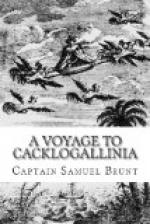But its reflection of the economic background of the age is not the only reason for the interest and importance of A Voyage to Cacklogallinia, either in its generation or in our own. The little tale has its place in the history of science, particularly in that movement of science which, beginning with the “new astronomy” in the early seventeenth century, was to produce one of the most important chapters in the history of aviation.[5] So far as literature is concerned, A Voyage to Cacklogallinia belongs to the literary genre of “voyages to the moon” which from Lucian to H.G. Wells (even to modern “pulp magazines”) have enthralled human imagination. Yet while its fantasy looks back to Lucian’s Icaro-Menippus, who flew to the moon by using the wing of a vulture and the wing of an eagle, its suggestion of the growing scientific temper of modern times makes it much more than mere fantasy. In the semilegendary history of Iran is to be found a tale, retold by Firdausi in the Shaknameh, of Kavi Usan, who “essayed the sky To outsoar angels” by fastening four eagles to his throne. The Iranian motif was adopted in the romances of Alexander the Great and so passed into European literature. The researches of Leonardo da Vinci upon the muscles of birds and the principles of the flight of birds brought over to the realm of science ideas long familiar in tale and legend. Francis Bacon did not hesitate to suggest in his Natural History (Experiment 886) that there are possibilities of human flight by the use of birds and “advises others to think further upon this experiment as giving some light to the invention of the art of flying.”
John Wilkins, one of the most influential early members of the Royal Society, in his Mathematicall Magick,[6] in 1648, suggested “four several ways whereby this flying in the air hath been or may be attempted.” He listed, as the second, “By the help of fowls.” Ten years earlier there appeared in England during the same year two works which were to have great influence in popularizing the theme of light: Wilkins’s Discovery of a World in the Moone,[7] a serious semiscientific work on the nature of the moon and the possibility of man’s flying thither, and a prose romance by Francis Godwin, The Man in the Moone: or, A Discourse of a Voyage thither by D. Gonsales.[8] These two works were largely responsible for the emergence of the old theme of flight to the moon in imaginative literature; the English translation of Lucian at almost the same time perhaps aided in advancing the popularity of the idea.
The similarities between Brunt’s romance and Godwin’s tale a century earlier are too striking to be fortuitous, and, indeed, there is no question that Brunt used Godwin as one of his chief sources. An earlier Robinson Crusoe, an idyllic Gulliver’s Travels, Godwin’s The Man in the Moone helped to establish in English literature the vogue of the traveler’s tale to strange countries. Domingo, like Captain Samuel Brunt, draws from the “exotic” tradition. Both travelers find themselves in strange lands; both experience many other adventures before they make their way to the moon, drawn by birds.




